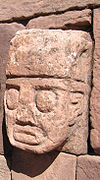By Heather Pringle
 I’m very happy to be back blogging here in this space.  Starting today, I’ll be posting here on the last Friday of every month. Before I begin, however, I’d like to thank the readers who tracked me down and sent me emails asking why I stopped.   I’ll try not to disappear again.
I’m very happy to be back blogging here in this space.  Starting today, I’ll be posting here on the last Friday of every month. Before I begin, however, I’d like to thank the readers who tracked me down and sent me emails asking why I stopped.   I’ll try not to disappear again.
The story that really riveted my attention this month came out of Bolivia, where local authorities seem to have gone a little crazy with their reconstruction efforts at the World Heritage Site of Tiwanaku. For those of you who missed the online coverage, here’s the situation in brief.
The sprawling monumental site of Tiwanaku, which dates back to some 1500 BC, has never  made it onto the radar of international tourists, in the way, say,  that Machu Picchu or the Nazca Lines in neighboring Peru have. Indeed guidebooks such as Lonely Planet often seem to discourage visitors from making the drive from La Paz to Tiwanaku, noting that one of its main attractions, the Akapana pyramid, “was in a rather sorry state.â€
So local authorities in Bolivia decided to remedy the situation by making the ruins a lot more impressive and tourist friendly.   They obtained funds for a major reconstruction of the Akapana pyramid and raised tiers of clay-brick walls on the original stone foundation. But the new construction stands out like a sore thumb. “They decided to go free-hand with the design,†complained one Bolivian archaeologist to journalists.  “There are no studies showing that the walls really looked like this.â€Â Worse still, the heavy adobe could bring the original stone-wall stubs toppling down.
One might think this is an isolated case of reconstruction mania. But I’m afraid this is far from the case. In Myanmar, for example, authorities set local brick-layers to work restoring 700-year-old Buddhist temples with little more than a single page of drawings as a guide. And researchers have raised the alarm for years about Arthur Evans’ reconstruction of the Minoan site of Knossos in Greece.
During my own travels in Peru this summer, I saw large teams of workers rebuilding walls at archaeological sites just about everywhere I went in the highlands around Cuzco. The goals, as I understand it, are highly laudable:  Peru’s Institute of National Culture (INC) wants to attract tourists to a host of very cool but little-known Inca sites in the backcountry, thus relieving some of the intense visitor pressure on Machu Picchu. It also wants to funnel tourists through little visited Andean towns and hamlets, where backpacker traffic would offer a real boost to the local economy.
To achieve all this, the INC has gotten into reconstruction in a huge way.  Its workers generally use the right materials and they try very hard to replicate the work of ancient masons. But the care they take has created a new problem:  It is becoming exceedingly difficult to discern what is real and what is restored. Moreover, some archaeologists I chatted with raised serious questions about the scientific basis for the reconstructions.
All this will create major headaches for Andean archaeologists down the line. The current generation of researchers, who have seen the sites in their pristine condition and who have a good idea of what’s authentic, will soon retire, leaving a new generation of Andean archaeologists just scratching their heads. Where does fact end and fancy begin?
The damage may not be irreversible (as archaeologists discovered at pyramid site in El Salvador), but I personally think that the reconstructionists often miss the boat.  While there’s clearly room for some judicious, meticulously planned site restoration, a little of this goes a very long way. In my experience, the most memorable sites by far are ones that still leave a lot of blank slate for the imagination.
This entry was posted by Heather Pringle on
Friday, October 30, 2009.
Discussion of this blog entry is now closed.
Comments posted here do not represent the views or policies of the Archaeological Institute of America.

